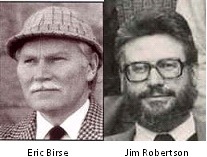The Birse and Robertson Archive
The Birse and Robertson archive is a unique collection of historical information on the status of Scottish plant communities, built up over the last 70 years. Eric Birse and Jim Robertson surveyed and studied Scottish vegetation between 1945 and 1985, firstly under the auspices of the Macaulay Institute for Soil Research, and later as part of the Macaulay Land Use Research Institute. During this period they collected almost 7000 records of vegetation composition, many with accompanying soil profile information. The records cover all major Scottish vegetation types and were collected throughout Scotland. This information was subsequently used to develop a vegetation classification for Scotland, published as ‘Plant communities of Scotland’ in 1980.
Long term vegetation change

 Resurveys
Resurveys
Between 2004 and 2014 approximately 1500 of the original survey locations were re-visited and re-surveyed as part of Scottish Government funded projects to investigate long term change in Scottish vegetation. Resurveyed habitats included alpine, moorland, woodland, wetland and grassland vegetation types. The habitat resurveys have resulted in a number of publications describing vegetation change in Scotland over the last 30-50 years and relating this to changes in climate, pollution and land-use.
Creating the archive

For further information about the Birse and Robertson Archive, or if you are interested in collaborating or using the data, please contact Dr Andrea Britton at andrea.britton@hutton.ac.uk. Download an information leaflet here or from the image of the leaflet.
Acknowledgements
The development of the Birse and Robertson Archive was supported by the Scottish Government RESAS under its underpinning capacity funding.
Publications:
Pakeman, R.J., Hewison, R.L., Riach, D., Fisher, J.M., Hurskainen, S., Fielding, D.A., Mitchell, R.J. (2017) Long-term functional structure and functional diversity changes in Scottish grasslands. Agriculture Ecosystems and Environment, 247: 352-362.
Mitchell, R.J., Hewison, R.L., Britton, A.J., Brooker, R., Cummins, R., Fielding, D., Fisher, J., Gilbert, D., Hester, A., Hurskainen, S., Pakeman, R., Potts, J., Riach, D. (2017) Forty years of change in Scottish grassland vegetation: increased richness, decreased diversity and increased dominance. Biological Conservation, 212: 327-336.
Britton, A.J., Hewison, R.L., Mitchell, R.J., Riach, D. (2017) Pollution and climate change drive long-term change in Scottish wetland vegetation composition. Biological Conservation, 210: 72-79.
Britton, A.J., Hester, A.J., Hewison, R.L., Potts, J., Ross, L.C. (2017) Climate, pollution and grazing drive long-term change in moorland habitats. Applied Vegetation Science. 20: 194-203.
Britton, A.J.,Beale, C.M., Towers, W. & Hewison, R.L. (2009) Biodiversity gains and losses: evidence for homogenisation of Scottish alpine vegetation. Biological Conservation 142, 1728-1739.







